|
|
 |
|
Cyclopoida ( Order ) |
|
|
|
Oncaeidae ( Family ) |
|
|
|
Oncaea ( Genus ) |
|
|
| |
Oncaea media Giesbrecht, 1891 (F,M) | |
| | | | | | | Syn.: | Oncäa media Giesbrecht, 1891; 1892 (p.591, 602, 774, figs.F,M);
no O. media : Giesbrecht, 1892 (pl.47: fig.11); Razouls, 1972 (p.95, Annexe: p.113, figs.F, non M); 1974 b (p.238, figs.F, non M);
O. curta : Corral Estrada & Genicio de Corral, 1970 (p.30, pl.XII, figs.1-5)
Oncaea media hymena Peterson & Miller, 1975 (p.642, 650, occurrence); 1976 (p.14, Table 1, 2, abundance vs interannual variations); 1977 (p.717, Table 1, seasonal occurrence)
'Oncaea media group' : Siokou & al., 2013 (p.1313, fig.4, 8, biomass, vertical distribution). | | | | Ref.: | | | Thompson & Scott, 1903 (p.239); A. Scott, 1909 (p.242, Rem.); Wolfenden, 1911 (p.362); Pesta, 1912 a (p.58, fig.F); 1913 (p.33); 1920 (p.651, fig.); Früchtl, 1924 b (p.88); Farran, 1926 (p.297); 1929 (p.210, 285); Rose, 1929 (p.57); 1933 a (p.298, figs.F,M); Dakin & Colefax, 1933 (p.208); Farran, 1936 a (p.126); ? Mori, 1937 (1964) (p.120, figs.F,M); ? Dakin & Colefax, 1940 (p.117, fig.F); Sewell, 1947 (p.261, Rem.: 2 forms); 1951 (p.375, figs.M,F, Rem.: parasites); Chiba & al., 1957 (p.310); 1957 a (p.12); Tanaka, 1960 (p.69, figs.F,M, F; "minor"); Vilela, 1965 (p.15); 1968 (p.32); Corral Estrada, 1970 (p.219, Rem.); Silas, 1972 (p.635); Björnberg, 1972 (p.89, figs., Rem.N, juv.); ? Chen & al., 1974 (p.41, figs.F,M, p.75: Rem.); Razouls, 1974 b (p.238, figs.M, ? F); Ferrari, 1975 (p.222, figs.F,M, Rem.); Boxshall, 1977 a (p.133, figs.F, Rem.); Dawson & Knatz, 1980 (p.9, 10, figs.F,M); Björnberg & al., 1981 (p.667, figs.F); Sazhina, 1982 (p.1161, Rem., fig.N); Malt, 1982 a (p.130, figs.N, juv., F); 1983 a (p.7, figs.F, M, Rem.); Sazhina, 1985 (p.93, figs.N); Kim & al., 1993 (p.271); Heron & Bradford-Grieve, 1995 (p.36, figs.F,M); Chihara & Murano, 1997 (p.980, Pl.224: F,M); Boxshall, 1998 (p.226, Rem.); Bradford-Grieve & al., 1999 (p.887, 970, figs.F,M); Böttger-Schnack, 2001 (p.54, 57, figs.F,M, Rem.); Conway & al., 2003 (p.221, figs.F,M, Rem.); Boxshall & Halsey, 2004 (p.614: fig.M, f. minor); Conway, 2006 (p.22, copepodides 1-6, Rem.); Elvers & al., 2006 (p.506, tab.3, fig.2); Avancini & al., 2006 (p.135, Pl. 103, figs.F,M, Rem.); Ferrari & Dahms, 2007 (p.57, 71, Rem.); Wi & al., 2009 (p.105, figs.F,M, Rem.); Böttger-Schnack & Schnack, 2009 (p.142: Rem.); Vives & Shmeleva, 2010 (p.290, figs.F,M, Rem.); Böttger-Schnack & Schnack, 2013 (p.4: Table 1, Rem.: s.str-Group) | 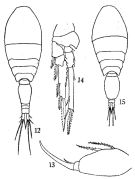 issued from : Q.-c Chen & S.-z. Zhang & C.-s. Zhu in Studia Marina Sinica, 1974, 9. [Pl.6, Figs.12-15]. With doubt. Female (from off-shore Chekiang): 12, habitus (dorsal); 13, Mxp; 14, P4. Male: 15, habitus (dorsal).
|
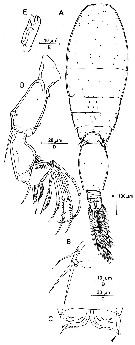 issued from : R. Böttger-Schnack in Bull. nat. Hist. Mus. Lond. (Zool.), 2001, 67 (1). [p.356, Fig.16]. Male (from Red Sea): A, habitus (dorsal); B, P5 (dorsal); C, P6 (aberrant posterolateral corner arrowed); D, A2 (anterior); E, Md. Nota: Proportional lengths (%) of urosomites and caudal rami 10.9: 58.7: 3.8:3.3:3.8:7.6:11.9.
|
 issued from : R. Böttger-Schnack in Bull. nat. Hist. Mus. Lond. (Zool.), 2001, 67 (1). [p.56, Table 4]. Sexual dimorphism in spine length (mm) on distal endopod segment of P2-P4 in O. media from the Red Sea. (Data represent single measurments).
|
 issued from : R. Böttger-Schnack in Bull. nat. Hist. Mus. Lond. (Zool.), 2001, 67 (1). [p.57, Table 5]. List of important characters separating O. media and related species. Data of O. curta after Sars (1918), remaining data from present study.
|
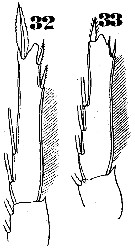 Issued from : W. Giesbrecht in Systematik und Faunistik der Pelagischen Copepoden des Golfes von Neapel und der angrenzenden Meeres-Abschnitte. – Fauna Flora Golf. Neapel, 1892. Atlas von 54 Tafeln. [Taf.47, Figs.32, 33]. As Oncäa media. Male: 32, endopodal segment 3 of P3; 33, endopodal segment 3 of P2.
|
 issued from : G.A. Boxshall in Bull. Br. Mus. nat. Hist. (Zool.), 1977, 31 (3). [p.132, Fig.16, f-k]. Female (from 18°N, 25°W): f, urosome (dorsal); g, A2 (anterior); h, Md (anterior); h, Md (anterior); i, Mx1 (anterior); j, Mxp (anterior; k, P4 (posterior).
|
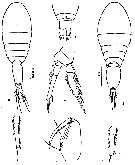 issued from : Z. Zheng, S. Li, S.J. Li & B. Chen in Marine planktonic copepods in Chinese waters. Shanghai Sc. Techn. Press, 1982 [p.101, Fig.59]. Doubtful. Female: a, habitus (dorsal); b, Mxp; c, P4. Male: d, habitus (dorsal); e, urosome (ventral); f, endopodal segments 2 and 3 of P2; g, endopodal segments 2 and 3 of P3. Scale bars in mm.
|
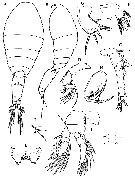 issued from : J.H. Wi, Y.H. Yoon & H.Y. Soh in Ocean Sci. J., 2009, 44 (2). [p.106, Fig.8]. Female (from S Korea): A-B, habitus (dorsal and lateral, respectively); C, A1; D, A2; E, labrum (posterior); F, Md; G, Mx1; H, Mxp; I, P1; J, P5. Scale bars in micrometers.
|
 issued from : J.H. Wi, Y.H. Yoon & H.Y. Soh in Ocean Sci. J., 2009, 44 (2). [p.108, Fig.9, A-C]. Female: A, P2; B, P3; C, P4. Scale bar in micrometers.
|
 issued from : J.H. Wi, Y.H. Yoon & H.Y. Soh in Ocean Sci. J., 2009, 44 (2). [p.108, Fig.9, D-J]. Male: D-E, habitus (dorsal and lateral, respectively); F, A2; G, Mxp; H, endopodite 3 of P2; I, endopodite 3 of P3; J, P6 (represented by posterolateral flap closing off genital aperture on each side). Scale bars in micrometers.
|
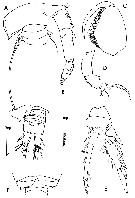 issued from : C. Razouls in Vie Milieu, 1974 b (p. , figs.M) Male from Banyuls, G. of Lion): A, urosome (dorsal); B, A1; C, Mxp; D, A2 (setae on distal segment missing); E, P4; F, distal expansion on genital segment).
|
 Issued from : G.A. Heron & J.M. Bradford-Grieve in New Zealand Oceanogr. Inst Memoir 104. NIWA, 1995. [p.37, Fig.16]. Female: a, habitus (dorsal) [r]; b, right A1 [s]; c, right A2 [z]; d, labrum (ventral) [t]; e, right Md [u]; f, left Mx1 [u]; g, left Mx2 [z]; h, right Mxp [z]; i, P1 [z]; j, P2 [z]; k, P3 [z]. Scales in p.13, FIg.2. Letter in brackets. Nota: A double scallop pattern of sclerotisation between gonopores, located at posterior margin of anterior third of genital segment. P6 probably represented by spiniform setule on external genital area. Caudal ramus length about double that of width.
|
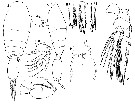 Issued from : G.A. Heron & J.M. Bradford-Grieve in New Zealand Oceanogr. Inst Memoir 104. NIWA, 1995. [p.38, Fig.17, a-i]. Female: a, P4 [z]; b, segment of P5 [z]. Male (from Bay of Naples): c-d, habitus (lateral and dorsal, respectively) [r]; e, 3rd segment of left A2 [t]; f, right Mxp [z]; g, 3rd endopodal segment of P2 [z]; h, 3rd endopodal segment of P3 [z]; i, 3rd endopodal segment of P4 [z]. Scales in p.13, Fig.2. Letter in brackets. Nota: P5 with small free segment; 2 terminal setae, the outer 2/3 the length of inner seta; seta on body near leg.
|
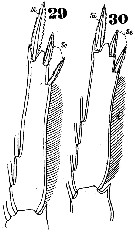 Issued from : W. Giesbrecht in Systematik und Faunistik der Pelagischen Copepoden des Golfes von Neapel und der angrenzenden Meeres-Abschnitte. – Fauna Flora Golf. Neapel, 1892. Atlas von 54 Tafeln. [Taf.47, Figs.29, 30]. As Oncäa media. Female: 29, endopodal segment 3 of P3; 30, endopodal segment 3 of P2.
|
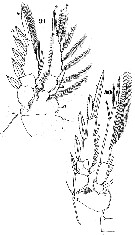 Issued from : W. Giesbrecht in Systematik und Faunistik der Pelagischen Copepoden des Golfes von Neapel und der angrenzenden Meeres-Abschnitte. – Fauna Flora Golf. Neapel, 1892. Atlas von 54 Tafeln. [Taf.47, Figs.29, 30]. As Oncäa media. Female: 29, endopodal segment 3 of P3; 30, endopodal segment 3 of P2.
|
 Issued from : W. Giesbrecht in Systematik und Faunistik der Pelagischen Copepoden des Golfes von Neapel und der angrenzenden Meeres-Abschnitte. – Fauna Flora Golf. Neapel, 1892. Atlas von 54 Tafeln. [Taf.47, Fig.1]. As Oncäa media. Female: 1, habitus (dorsal).
|
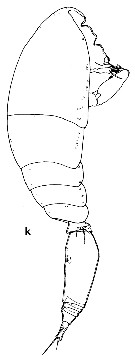 issued from : G.A. Heron & J.M. Bradford-Grieve in New Zealand Oceanogr. Inst. memoir 104. NIWA, 1995. [p.35, Fig.15, k]. Female (from Gulf of Naples): k, habitus (lateral) [r] Scale bars: See p.13, fig.2. Letter in brackets.
|
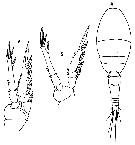 Issued from : O. Tanaka in Spec. Publs. Seto mar. biol. Lab., 10, 1960 [Pl. XXXI, 4-6]. Female (from South China Sea and Indian Ocean): 4, habitus (dorsal); 5, P4; 6, P4 (forma major). Nota: The prsent females ranged in size from 0.55 mm to 0.79 mm Prosome and urosome in the proportional lengths 63 to 37. Proportional lengths of the urosomal segments and caudal rami 10 : 54 : 4 : 7 : 8 : 16 = 100. Caudal rami 2/6 times as long as broad. The distal abdominal segments are of yellowish brown colour.
|
 Issued from : O. Tanaka in Spec. Publs. Seto mar. biol. Lab., 10, 1960 [Pl. XXXI, 7-9]. Male: 7, abdomen (dorsal (specimen from 0.74 mm); 8, same (specimen from 0.56 mm); 9, same (specimen from 0.93 mm). Length 0.51-0.60 and 0.70-0.93 mm. The males varies greatly in size. Proportional lengths of the urosomal segments and caudal rami are two types: Large form: 11 : 62 : 5 : 3 : 3 : 5 : 11 = 100 Small form: 12 : 62 : 5 : 2 : 2 : 5 : 12 = 100. Caudal rami about 2.6 times as long as broad. Remarks: In the present material the small form is much inferior in number; these two forms differ only in size, and there is no structural difference.
|
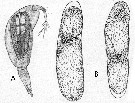 Issued from : E. Chatton in Arch. Zool. Exp. & Gen., 1920, 59, [p.167, Fig.68]. Oncaea media female parasited by Blastodinium mangini var. oncaae (Dinoflagellate). A, lateral view with the parasites inside the gut; B, two individuals.
| | | | | Compl. Ref.: | | | Cleve, 1904 a (p.193); Pearson, 1906 (p.35); Chatton, 1920, p.18, parasites); Rose, 1925 (p.152); Gurney, 1927 (p.167, Rem.)Wilson, 1942 a (p.198); Massuti Alzamora, 1942 (p.102, Rem.); Sewell, 1948 (p.357, 461); Yamazi, 1958 (p.154, Rem.); Deevey, 1960 (p.5, Table II, annual abundance); Fagetti, 1962 (p.43); V.N. Greze, 1963 a (tabl.2); Shmeleva, 1963 (p.141); Duran, 1963 (p.25); Giron-Reguer, 1963 (p.58); Gaudy, 1963 (p.31, Rem.); Björnberg, 1963 (p.78, Rem.); Unterüberbacher, 1964 (p.34); De Decker, 1964 (p.16, 23, 30, 32); De Decker & Mombeck, 1964 (p.13); Anraku & Azeta, 1965 (p.13, Table 2, fish predator); Furuhashi, 1966 a (p.295, vertical distribution in Kuroshio region, Table 9);Neto & Paiva, 1966 (p.31, Table III); Mazza, 1966 (p.73); Pavlova, 1966 (p.45); Evans, 1968 (p.14); Delalo, 1968 (p.139); Vinogradov, 1968 (1970) (p.268); Paulmier, 1971 (p.168); Deevey, 1971 (p.224); Della Croce & al., 1972 (p.1, Rem.); Ibanez & Seguin, 1972 (p.81, annual cycle, multivarite analysis); Binet & al., 1972 (p.73); Apostolopoulou, 1972 (p.329, 378); Bainbridge, 1972 (p.61, Appendix Table I: vertical distribution vs day/night, Table 88: %); Björnberg, 1973 (p.362, 388); Chatton & M.O. Soyer, 1973 (p.27, fig.1, parasite); Corral Estrada & Pereiro Muñoz, 1974 (tab.I); Vives al., 1975 (p.56, 57, tab.II, III); Peterson & Miller, 1975 (p.650); Zalkina, 1977 (p.339, tab.1); Boxshall, 1977 b (p.548); Deevey & Brooks, 1977 (p.156, tab.2, Station "S"); Hanaoka, 1977 (p.267, 300, abundance); Nyan Taw & Ritz, 1979 (p.196); Binet, 1979 (p.400); Dessier, 1979 (p.202, 207); Chen Q-c, 1980 (p.795); Vaissière & Séguin, 1980 (p.23, tab.2); Hirota 1981 (p.19, Table 1, length-weight-CHN); Star & Mullin, 1981 (p.1322, abundance); Vives, 1982 (p.295); Kovalev & Shmeleva, 1982 (p.85); Bityukov & al., 1984 (tab.1); Scotto di Carlo & al., 1984 (p.1041); Guangshan & Honglin, 1984 (p.118, tab.); Binet, 1984 (tab.3); d'Elbée, 1984 (p.25, Fig.6); Regner, 1985 (p.11, Rem.: p.40); Jansa, 1985 (p.108, Tabl.I, II, III, IV); Sazhina, 1985 a (p.491, tab.3); Valentin & al., 1986 (p.117, Table V); Brinton & al., 1986 (p.228, Table 1); Jimenez-Perez & Lara-Lara, 1988; Lozano Soldevilla & al., 1988 (p.61); Williams D. & al., 1988 (p.580); Krsinic & Vilicic, 1989 (p.12, tab.3); Cervantes-Duarte & Hernandez-Trujillo, 1989 (tab.3); Pancucci-Papadopoulou & al., 1990 (p.199); Pancucci-Papadopoulou & al., 1990 (p.199); Othman & al., 1990 (p.561, 564, Table 1); Hirakawa & al., 1990 (tab.3); Yoo, 1991 (tab.1); Böttger-Schnack, 1992 (p.304); Seguin & al., 1993 (p.23); Lopes, 1994 (tab.1); Uye & Kaname, 1994 (p.43, length v.s. fecal pellet volume); Böttger-Schnack, 1994 (p.277); Shih & Young, 1995 (p.77); Böttger-Schnack, 1996 (p.1086); Kotani & al., 1996 (tab.2); Fernandez de Puelles & al., 1996 (p.97, occurrence: p.101); Böttger-Schnack, 1997 (p.409); Sharaf & Al-Ghais, 1997 (tab.1); Park & Choi, 1997 (Appendix); Noda & al., 1998 (p.55, Table 3, occurrence); Hure & Krsinic, 1998 (p.83, 104); Krsinic, 1998 (p.1051); Lopes & al., 1998 (p.195, tab.2); Hsieh & Chiu, 1998 (tab.2); Suarez-Morales & Gasca, 1998 a (p.112); Siokou-Frangou, 1999 (p.479); Siokou-Frangou & al., 1999 (p.205, Table 5); Lavaniegos & Gonzalez-Navarro, 1999 (p.239, Appx.1); El-Serehy, 1999 (p.172, Table 1, occurrence); Lopes & al., 1999 (p.215, tab.1); Neumann-Leitao & al., 1999 (p.153, tab.2); Harvey & al., 1999 (p.1, 49: Appendix 5, in ballast water vessel); Ueda & al., 2000 (tab.1); d'Elbée, 2001 (tabl.1); Fernandez-Alamo & al., 2000 (p.1139, Appendix); Seridji & Hafferssas, 2000 (tab.1); Lopez-Salgado & al., 2000 (tab.1); Moraitou-Apostolopoulou & al., 2000 (tab.I, fig.6); El-Serehy & al., 2001 (p.116, Table 1: abundance vs transect in Suez Canal); Böttger-Schnack & al., 2001 (p.1029, tab.1, 2); Zerouali & Melhaoui, 2002 (p.91, Tableau I); Sameoto & al., 2002 (p.13); Vukanic, 2003 (p.139, tab.1); Hwang & al., 2003 (p.193, tab.2); Hsieh & al., 2004 (p.398, tab.1); Rezai & al., 2004 (p.490, tab.2, 3, abundance, Rem., p.495, tab.8); Daly Yahia & al., 2004 (p.366, fig.1); Lan & al., 2004 (p.332, tab.1); Lo & al.*, 2004 (p.218, fig.6); Kang & al., 2004 (p.1523, figs.7, 9); Nishibe & Ikeda, 2004 (p.931, Tab. 2, 4, 5); Kazmi, 2004 (p.231); Lakkis & al., 2005 (p.152: forma minor); Baker & al., 2005 (tabl.); Choi & al., 2005 (p.710: Tab.III); Obuid Allah & al., 2005 (p.123, occurrence % vs metal contamination); Uriarte & Villate, 2005 (p.863, tab.I); Zuo & al., 2006 (p.164: tab.1); Isari & al., 2006 (p.241, tab.II); Hwang & al., 2006 (p.943, tabl. I); Sterza & Fernades, 2006 (p.95, Table 1, occurrence); Dias & Araujo, 2006 (p.88, Rem., chart); Zervoudaki & al., 2006 (p.149, Table I); Hwang & al., 2007 (p.25); Valdés & al., 2007 (p.104: tab.1); Khelifi-Touhami & al., 2007 (p.327, Table 1); McKinnon & al., 2008 (p.844: Tab.1, p.846: Tab.II, fig.7); Lopez Ibarra, 2008 (p.1, Table 1, fig.11: abundance); Isinibilir & al., 2008 (p.745: Tab.1); Cabal al., 2008 (289, Table 1); Humphrey, 2008 (p.85: Appendix A); Neumann-Leitao & al., 2008 (p.799: Tab.II, fig.6); Tseng L.-C. & al., 2008 (p.153, fig.5, Table 2, occurrence vs geographic distribution, indicator species); Ohtsuka & al., 2008 (Table 4, Rem.: in Osaka Harbor); Pagano, 2009 (p.116); C.-Y. Lee & al., 2009 (p.151, Tab.2); Miyashita & al., 2009 (p.815, Tabl.II); Skovgaard & Salomonsen, 2009 (p.425, Table 2) Böttger-Schnack & Schnack, 2009 (p.131, Table 3, 4, Rem.); Licandro & Icardi, 2009 (p.17, Table 4); Nishibe & al., 2009 (p.491, Table 1: seasonal abundance); C.E. Morales & al., 2010 (p.158, Table 1); Hafferssas & Seridji, 2010 (p.353, Table 2); Lidvanov & al., 2010 (p.356, Table 3); Hernandez-Trujillo & al., 2010 (p.913, Table 2); Hidalgo & al., 2010 (p.2089, fig.2, 4, Table 2, cluster analysis); Mazzocchi & Di Capua, 2010 (p.429); Medellin-Mora & Navas S., 2010 (p.265, Tab. 2); Fazeli & al., 2010 (p.153, Table 1); W.-B. Chang & al., 2010 (p.735, Table 2, 4, fig.5, abundance); Hsiao S.H. & al., 2011 (p.475, Appendix I); Hsiao & al., 2011 (p.317, Table 2, indicator of seasonal change); Maiphae & Sa-ardrit, 2011 (p.641, Table 2, 3, Rem.); Tseng L.-C. & al., 2011 (p.47, Table 2, occurrences vs mesh sizes); Moscatello & al., 2011 (p.80, Table 4); Selifonova, 2011 a (p.77, Table 1, alien species in Black Sea); Isari & al., 2011 (p.51, Table 2, abundance vs distribution); Beltrao & al., 2011 (p.47, Table 1, density vs time); Tutasi & al., 2011 (p.791, Table 2, abundance distribution vs La Niña event); Andersen N.G. & al., 2011 (p.71, Fig.3: abundance); Shiganova & al., 2012 (p.61, Table 4); Glushko & Lidvanov, 2012 (p.138, Tableau 1, 3); Uysal & Shmeleva, 2012 (p.909, Table I); Bode & al., 2012 (p.108, spatial distribution vs time-series, % biomass); DiBacco & al., 2012 (p.483, Table S1, ballast water transport); Lavaniegos & al., 2012 (p. 11, Appendix); Salah S. & al., 2012 (p.155, Tableau 1); Naz & al., 2012 (p.61, Table 4, relative abundance); Hidalgo & al., 2012 (p.134, Table 2) ; Gubanova & al., 2013 (in press, p.4, Table2); Belmonte & al., 2013 (p.222, Table 2, abundance vs stations); Tachibana & al., 2013 (p.545, Table 1, seasonal change 2006-2008); Tseng & al., 2013 (p.507, seasonal abundance); Jagadeesan & al., 2013 (p.27, Table 3, seasonal variation); Anjusha & al., 2013 (p.40, Table 3, abundance & feeding behavior); Sobrinho-Gonçalves & al., 2013 (p.713, Table 2, fig.8, seasonal abundance vs environmental conditions); Lidvanov & al., 2013 (p.290, Table 2, % composition); Hwang & al., 2014 (p.43, Appendix A: seasonal abundance); Fernandez de Puelles & al., 2014 (p.82, Table 3, seasonal abundance); Bonecker & a., 2014 (p.445, Table II: frequency, horizontal & vertical distributions); Lopez-Ibarra & al., 2014 (p.453, fig.6, biogeographical affinity); Dias & al., 2015 (p.483, Table 2, abundance, biomass, production, Table 4: % vs. season); Zaafa & al., 2014 (p.67, Table I, occurrence); Mazzocchi & al., 2014 (p.64, Table 3, 4, occurrence); Fierro Gonzalvez, 2014 (p.1, Tab. 3, 4, 5, occurrence, abundance) ; Rosa J.C.L. & al., 2016 (p.67, Rem.: p.70); Zakaria & al., 2016 (p.1, Table 1); Benedetti & al., 2016 (p.159, Table I, fig.1, functional characters); Ben Ltaief & al., 2017 (p.1, Table III, Summer relative abundance); Marques-Rojas & Zoppi de Roa, 2017 (p.495, Table 1); Jerez-Guerrero & al., 2017 (p.1046, Table 1: temporal occurrence); El Arraj & al., 2017 (p.272, table 2, spatial distribution); Benedetti & al., 2018 (p.1, Fig.2: ecological functional group); Dias & al., 2018 (p.1, Tables 4, 5: % vs. season); Chaouadi & Hafferssas, 2018 (p.913, Table II: occurrence); Palomares-Garcia & al., 2018 (p.178, Table 1: occurrence) | | | | NZ: | 20 | | |
|
Distribution map of Oncaea media by geographical zones
|
| | | | | | | | | | | | | | |  issued from : A.V. Kovalev in Gidrobiol. Zh., 1970,
6 (5). [p.92, Table 1]. issued from : A.V. Kovalev in Gidrobiol. Zh., 1970,
6 (5). [p.92, Table 1].
Relation between the body length of females and number of eggs.
A: species; B: number of females; C: length of females in mm; D: number of eggs in relation to the lengths of females. |
| | | | Loc: | | | Cosmopolite (tropical, sub-tropical); ? Antarct. (Ross Is.: in Farran, 1929), South Africa (off Cape of Good Hope, E & W), Angola (Baia Farta), G. of Guinea, Ivorian shelf, off Morocco-Mauritania, Cap Ghir, Portugal, Brazil (S, off Rio de Janeiro, Cabo Frio, Campos Basin, Vitoria Bay, off Vitoria-Cabo de Sao Tomé, Guarau estuary, off Natal), Caribbean Colombia, Bahia de Mochima (Venezuela), Sargasso Sea, off Bermuda (Station "S"), Delaware Bay (outside), off E Nova Scotia, North Sea, NW Spain, off W Tangier, Medit. (M'Diq, Alboran Sea, Habibas Is., Baleares, Gulf of Annaba, G. of Gabes, Genova, Gulf of Taranto, Taranto Harbour, S Adriatic Sea (Vlora Bay), W-E Basins, W Egyptian coast, Lebanon Basin, Thracian Sea, Marmara Sea, Black Sea), Port Said, Suez Canal, G. of Aqaba, Safâga, N-S Red Sea, Gulf of Oman, G. of Aden, Arabian Gulf, UAE coast, Arabian Sea, Karachi coast, Laqccadive Is., Maldive Is., Sri Lanka, Madagascar (Nosy Bé), Seychelles, Indian, Gulf of Mannar, Palk Bay, Bay of Bengal, Straits of Malacca, G. of Thailand, Indo-Malaysia, Sulu Sea, China Seas (Yellow Sea, East China Sea, South China Sea), Taiwan Strait, Taiwan (E, S, SW, W, N, NW, NE), Korea (E, S), S Japan Sea , Nagasaki, Japan ( Kuchinoerabu Is., Kyushu: Ariake Bay, Tokyo Bay, Seto Inland Sea, Kuroshio & Oyashio regions, Oregon (off Newport), California, Baja California (Bahia Magdalena, La Paz); Gulf of California, Bahia de los Angeles, G. of Tehuantepec, Clipperton Is., Bahia Cupica (Colombia), Galapagos-Ecuador, Chile (N, off Santiago, Concepcion), Pacif. (W equatorial), Australia (North West Cape, G. of Carpentaria, SE, Great Barrier), New Caledonia, Tasman Sea, N New Zealand, Georgia Strait (Goat Is.) | | | | N: | 271 ? | | | | Lg.: | | | (34) F: 0,78-0,72; (35) [Atlant. N] F: 0,78-0,75; [Atlant. trop.] F: 0,95-0,84; [N-Z] F: 0,95-0,84; M: 0,65-0,58; (38) F: 0,79-0,72; (46) F: 0,82-0,55; M: 0,63-0,6; (66) F: 0,79-0,55; M: 0,93-0,70; 0,6-0,51; (91) F: 0,92-0,5; M: 0,8-0,6; (104) F: 0,9; ? (109) F: 0,65-0,80; M: 0,65-0,70; (139) F: 0,86-0,78; (237) F: 0,85-0,95; M: 0,70; (327) F: 0,92-0,69; M: 0,73; (373) F: 0,96-0,72; M: 0,63-0,61; (432) F: 0,75-0,67; (449) F: 0,82-0,55; M: 0,63-0,6; (687) F: 0,93-0,72; M: 0,63-0,56; (692) F: 0,69-0,46; M: 0,44-0,38; (786) F: 0,97-0,62; M: 0,75-0,64; (819) F: 0,65-0,77; M: 0,56; (864) F: 0,78-1,02; (866) F: 0,64-0,79; M: 0,5-0,7; (991) F: 0,50-0,92; M: 0,60-0,80; (1023) F: 0,73-0,78; M: 0,49; (1072*) F: 0,720-0,765; M: 0,546-0,589; (1101) F: 0,56-0,85; {F: 0,46-1,02; M: 0,38-0,93}
*: Body length in lateral aspect. | | | | Rem.: | epi-mesopelagic. Overall Depth Range in Sargasso Sea: 0-1000 m (Deevey & Brooks, 1977, Station "S"). 234-820 m at Station T-1 (E Tori Is., E middle Japan) from Furuhashi (1966 a).
The frequency of citations supports a Tethys origin.
The species seems better represented in the Atlantic than in the Pacific (in Wilson, 1942 a, p.198, but not cited in 1950), except in the eastern and south-west region.
Observed in the ballasts of ships at San Francisco.
For Gurney (1927, p.167) this species was found to be common at Suez and at Port Said, but was only taken once in the Canal at Kabret, and probably throughout the Canal, not seen owing to the very small size of the species.
Oncaea media major Sewell, 1947 (F,M)
Ref.: Sewell, 1947 (p.261, Rem.F); 1951 (p.375, Rem.); Malt, 1983 a (p.5, 7); Böttger-Schnack & al., 1989 (p.1089); 1995 (p.92) 1997 (p.409); Ohtsuka & al., 1996 a (p.91); Suarez-Morales & Gasca, 1998 a (p.112); Lakkis & al., 2005 (p.152)
Lg.: (11) F: 0,817-0,733; (46) F: 0,82-0,55; (180) F: 0,76-0,7; (788) F: 0,77-0,65; {F: 0,55-0,82}.br>Nota: The proportional lengths of the anterior and posterior regions of the body as 63 to 37. The proportional lengths of the segments of the posterior region (5th thoracic segment to caudal rami) as 11: 53:8: 6: 8: 14 = 100. Caudal rami are one and three-fourths times the length of the anal segment and about two and a half times as long as wide. The anal segment and caudal rami are in most examples covered with stout chitin, which in some instances is stained a rich orange-red colour.The various segments of A1 have the proportional lengths as 14:24:37:10:5:10 = 100. In Mxp the two spines arising from the 2nd basal segment are subequal.
Oncaea media minor Sewell,1947 (F,M)
Syn.: ? Oncaea sp.1 Ferrari, 1975 (p.228, figs.)
Ref.: Sewell, 1947 (p.261, Rem.F); 1951 (p.375, Rem.); Silas, 1972 (p.635); Malt,1983 a (p.5, 7); Böttger-Schnack & al., 1989 (p.1089); Huys & Boxshall, 1991 (p.292, 304, 311, figs.F,M); Böttger-Schnack, 1992 (p.304); Ohtsuka al., 1996 a (p.91); Böttger-Schnack, 1997 (p.409); Boxshall & Halsey, 2004 (p.614: fig.M)
Lg.: (11) F: 0,65-0,58; M: 0,683-0,533; (180) F: 0,65-0,61 (no ! 1,65- 1,61); (788) F: 0,52-0,48; M: 0,44-0,41; {F: 0,48-0,65; M: 0,41-0,68}
Nota:
The proportional lengths of the various segments of the posterior region of the body (5th thoracic segment to caudal rami) as 11:51:8:6:9:15 = 100. In this form the caudal rami appear to be somewhat more slender than in forma major. The proportional lengths of the segments of A1 as 14 : 25: 37: 10: 4: 10 = 100.
Rem.: often confused with Oncaea scottodicarloi.
For Boxshall (1977, p.134) O. media and O. curta are closely related species and are usually separated primarily on the basis of the proportional lengths of the urosome somites in the females. Numerous specimens have been found which possess body proportions intermediate between the two species. The wide range of body form exhibited by female O. curta includes forms that approach typical O. media and it is necessary now to reappraise the criteria used to separate these two species (see Tables 4 and 5 above).
After Benedetti & al. (2018, p.1, Fig.2) this species belonging to the functional group 5 corresponding to small sac-spawning detritivorous.
See in DVP Conway & al., 2003 (version 1)
| | | Last update : 25/10/2022 | |
| | | | Oncaea media Giesbrecht is often mixed up with O. scottodicarloi and O. waldemari. Morphological separation between the first two species are given in detail by Heron & Bradford-Grieve (1995), who also pointed out that Giesbrecht´s drawing of the female urosome of O. media (his plate 47, fig. 11) in fact showed the urosome of O. scottodicarloi. Thus, Giesbrecht´s figure of the female urosome shown in this database (above) should be omitted or a corresponding remark should be added to the legend. For a morphological distinction between all three species of the media-complex see Böttger-Schnack (2001).
|
| | | The female urosome of Oncaea media figured by Razouls 1974 (his Fig. 5A) was obviously not based on an adult specimen (deficient number of urosome segments). Later on, this (incorrect) figure was also included in the publication by Conway et al (2003).
| |
|
|
|
 Any use of this site for a publication will be mentioned with the following reference : Any use of this site for a publication will be mentioned with the following reference :
Razouls C., Desreumaux N., Kouwenberg J. and de Bovée F., 2005-2024. - Biodiversity of Marine Planktonic Copepods (morphology, geographical distribution and biological data). Sorbonne University, CNRS. Available at http://copepodes.obs-banyuls.fr/en [Accessed April 25, 2024] © copyright 2005-2024 Sorbonne University, CNRS
|
|
 |
 |






















